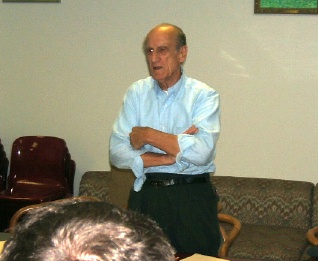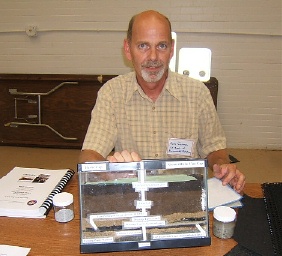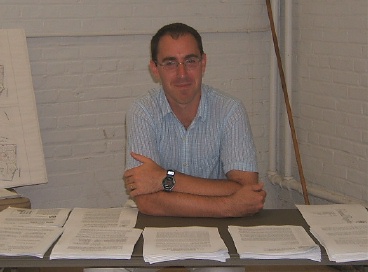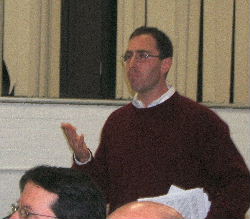 |
|
September 29, 2006
Newhall committee insists on 100 percent cleanup in its alternative to the state’s widely rejected plan
By Sharon Bass
With three weeks to go till the state clock strikes midnight, the Newhall Advisory Committee struggled again last night -- as it did last week -- to come up with an alternative cleanup plan for the neighborhood. The group unanimously turned down the proposal the state presented on Aug. 17.
And on Aug. 17, the Department of Environmental Protection, in turn, soundly turned down NAC’s initial remediation plan -- which called for a thorough overhaul of all contaminated properties -- when it unveiled its watered-down version at Southern Connecticut State University. Still, committee members made it clear they won’t settle for less. So after tidying up some loose ends, they expect to pitch the same basic plan to the DEP by the Oct. 20 deadline.
“We play by the rules. An alternative plan by the 20th,” said state Rep. Peter Villano (D-Hamden), the temporary chair of the NAC. “That puts us in the ballgame.” The DEP-paid facilitator for the group, attorney Kathleen Conway, was recently voted out of her position and the committee is going through transition aches and pains as it redefines itself.
“But the plan has already been turned down,” someone said.
“What would make it a reasonable plan?” said Abdul Hamid. “We’re not going to change our standards.”
Last Thursday, the committee used member Keith Darden’s tailored proposal as a starting point. He claims the DEP’s lead soil standards are much stricter than the federal Environmental Protection Agency’s, and should be relaxed. Under Darden’s plan, significantly fewer properties would need remediation and those with high contamination levels would be thoroughly cleaned, avoiding the much-dreaded environmental land use restriction. The state wants to slap those restrictions on properties with contaminants more than 4 feet deep -- in lieu of removing the deeper soil -- which would lower their real-estate value and require state permission to excavate below 4 feet.
But Thursday evening the NAC seemed to have scrapped Darden’s proposal in favor of Hamid’s, which includes the same tenets the DEP nixed in August. It also abides by the state's 400 per million parts of lead soil standard rather than the EPA's 1,200, meaning a much more extensive and expensive rehab.
Under Hamid’s “The Only Acceptable Plan,” all contaminated property would be excavated to “the depth required to assure removal of all toxic substances and replaced with clean soil”; contaminated soil would be shipped off site; homes with severe structural damage would get top priority attention to determine whether they’re salvageable; the “essential residential nature of the Neighborhood would be restored,” which includes the old middle school and the two parks as well as the houses; and a “perpetual neighborhood body” would be employed to oversee the remediation work.
In addition, Hamid wants “absolute surety that residents will not die of cancer and other unexplainable ailments or develop ailments caused by the pollutants in the Newhall area soil.” According to the state, no one's become ill from living or working in the area.
Attached to his proposal is a letter to DEP Commissioner Gina McCarthy, in which Hamid states that her plan would cost a little over $200 million but “our estimates are much higher. This is because our plan includes those areas that were totally neglected in your plan, such as structural damages and reimbursement to the property owners for all stress, distress, inconveniences … construction of new homes where homes are demolished …”
“I just don’t honestly believe giving them this plan is going to have any traction,” someone said.
But the other 10 in attendance voiced support for Hamid’s blueprint. (Darden was absent.)
“Keith [Darden] is trying to get the Legislature to change the [lead] standards,” said Elizabeth Hayes. “The community will not go for this. He’s been having little fireside chats with the legislators [Villano and state Sen. Martin Looney] to change the standards.”
She asked Villano if that was true. He said he has talks with Darden.
Member Henry Blue said the reason there’s still no plan in place -- let alone any cleanup action -- in the six years since the discovery of contaminants is because of the color of the residents’ skin.
“It’s only because it’s a black neighborhood,” he said. “Nobody wants to hear the truth.” Blue also called for a top-to-bottom cleanup.
While the proposal is not likely to fly, Villano said it is worth resubmitting. “Even though they turned it down, there’s value in repeating it,” he said. “It might be turned down but that shouldn’t prevent us from trying. There is no fallback position. This is it. The people have told us over and over that they want full cleanup.”
Villano said he wanted to wrap up the plan next week and hold a public hearing on it the following week. He said he was unsure what the next step would be if the DEP rejects Hamid’s proposal.September 22, 2006
'It’s Going to Be a Big Fight'

State Rep. Villano in his new role as NAC chair. Photo/Sharon Bass
Newhall committee regroups and readies a cleanup plan after rejecting the state’s
By Sharon Bass
When the Newhall Advisory Committee met last night, it was almost like its first meeting ever. After having a state-hired lawyer run the group, members unanimously gave her the boot last week and have taken over. Kind of like a civic coup.
The NAC was formed in response to the discovery six years ago of contaminated soil in the Highwood section around the old middle school on Newhall Street, where a dump once was. The state Department of Environmental Protection offered up a long-overdue cleanup plan last month. The NAC said no. So last night members worked on an alternative plan. They have until Oct. 20 to get it to the state for consideration.
But first they aired their feelings about the reorganization. Only nine of 21 members showed.
LaNorma Webb said she was unhappy about attorney Kathleen Conway being removed as group facilitator. “I don’t see she done anything wrong,” said Webb, though she voted to dismiss Conway. “She got us where we are at. She always had everything set up” for the meetings.
According to a financial statement the NAC received from the DEP, Conway billed the state $39,875 to run the monthly meetings from March 2005 to March 2006. Her contract was for $74,420, and it is unclear how much of the balance she's been paid to date. The committee felt it was an unnecessary expense. The DEP makes the final decision, however.
“We’re capable of running our own affairs and thought we could be more productive and have a free flow of conversation” without Conway, said state Rep. Peter Villano (D-Hamden), a NAC member who is now chairing the committee. He e-mailed DEP Commissioner Gina McCarthy Tuesday informing her of the decision to terminate Conway.
“We assume DEP as employer will officially notify Kathleen Conway of this change and will use a portion of the savings to engage required secretarial services for the NAC’s required public participation activities,” wrote Villano.
Last night was the committee's first public meeting in its new incarnation. It fumbled. For instance, the chair forgot to bring the attorney general’s response about who’s responsible for the structural damage caused by the contamination. And there was tension, particularly between the two newest members: Kelly McCarthy, a Yale Divinity School grad and tutor who ran for the 5th District Council seat last November, and Keith Darden, a Yale professor. But at the end of the two hours, the seeds of a viable plan emerged.
Darden had drafted a less costly, less invasive plan than the state’s, which the NAC used as a starting point. While the basic tenets of his plan were well received, McCarthy and Elizabeth Hayes disagreed with some of Darden’s ideas and conclusions, particularly on what the acceptable soil lead level should be.
The discussion opened with whether the state is responsible for compensating property owners with structurally damaged homes caused by the shifting landfill below. At the SCSU meeting last month, Commissioner McCarthy said the state was not responsible. However, Villano said in the attorney general’s recent opinion on the matter (the document he forgot to bring) the state may be liable under the Connecticut Superfund Act.
“I think it’s going to be a big fight,” he said, to get the DEP to agree. “Commissioner McCarthy is going to have to be drawn out. She is very strong in her opinions.”
“So now we need to put pressure on [Commissioner McCarthy],” said Darden.
What's RENEW?
Darden also put some pressure on Kelly McCarthy about disclosing a new nonprofit she formed to help relocate and provide other services for people whose properties will be remediated. Darden said McCarthy was keeping it secretive and wanted to know some details, like how it was being funded and if she was taking a salary.
McCarthy passed out a written overview of her new effort called RENEW, Inc. Her husband, Aaron Gustafson, is listed as the CFO. The board of directors include NAC member Henry Platt and Kim Miller and Evan Williams. McCarthy is the CEO.
Platt said neither he nor McCarthy gets paid. “In fact, we pitched in a little money,” he said. McCarthy said RENEW would seek grants, but not from the DEP.
“I wouldn’t have brought this [conflict between Darden and McCarthy] to the NAC but there was pressure on me,” she said. Villano said it was an issue between her and Darden.
The conversation turned to probably the most difficult issue: environmental land use restrictions. In Commissioner McCarthy’s proposal, ELURs would be slapped on 137 homes with contamination more than 4 feet below the surface. Residents and local politicians said that is entirely unacceptable. Home values would shrink and excavations more than 4 feet would require DEP permission.
Kelly McCarthy had sent Darden’s alt-remediation proposal to a “family friend” in Florida whom she said is an environmental engineer. In his opinion of the proposal, which was generally favorable, he wrote this about an ELUR: “This is the ‘kiss of death’ for property values in the area. Property disclosure law states you must inform any buyer of your property that an ELUR has been issued … ”
In Darden’s proposal, he argues the DEP’s lead standards are way too stringent. Lead is the main contaminate of concern, although there is also arsenic and other byproducts of an old decaying dump. High blood levels of lead in children are linked to learning and other cognitive disabilities. Darden said the federal Environmental Protection Agency’s standard is 1,200 mg/kg for soil while the DEP’s is 400, when remediation would be needed.
“The only way around LUR or prohibitive cost is to raise the limits on lead,” he said. “The DEP doesn’t want to yield on its standards because they get a bigger budget line” if there are more properties to clean up “and hand it out to their consultants.” The state is investigating whether the DEP has improperly handled the Newhall remediation money, a big chunk of which went to Loureiro Engineering Associates on several no-bid contracts.
Darden’s suggestion of using the EPA’s standard drew much criticism. Someone said the average soil lead level in the Northeast is 573 and many states have adopted standards of 400 and 500.
As people disagreed over the reasonable lead level, Platt came up with a suggestion. He said the standards could be relaxed on contaminated soil that is deeper than 4 feet, and retain the 400 standard for the top 4. That would prevent many of the ERULs.
“Henry, I’m glad you came up with that,” said McCarthy. “But I’m against lower standards because of children.” However, others thought the idea was worth exploring.
September 20, 2006
Open house for the Newhall remediation plan draws few
Story and photos by Sharon Bass
From 4 p.m. until 8:30 p.m. Tuesday, the Department of Environmental Protection held an open house in the Keefe Center to promote its cleanup plan for Newhall. Booths were set up around the old gym. A table was topped with cookies, coffee and mini bottles of spring water.
According to NAC member Keith Darden, who set up his own table, just 30 people came over the four and a half hours to learn more about the state’s proposal. Postcards about the open house were sent to residents’ homes.
“A lot of people don’t want to get up in a big meeting and ask questions,” DEP spokesman Dennis Schain said of the impetus for yesterday’s event. People could leave written comments about the DEP plan, ask questions about their property, find out about potential health risks and watch a video on how landfills and contaminated areas are capped.
Asked when the state’s finalized cleanup plan will be ready Schain said, “We’re going to take the time to carefully evaluate all comments we receive and then we will produce the final plan and release it as quickly as possible.” But he didn’t know whether that would be this year or next. The public comment period ends Oct. 20.
While the DEP dominated most of the scene, a few other entities set up shop. Like Regional Growth Partnership, a New Haven nonprofit. It’s working with the town on the old middle school reuse project. RGP’s Abbie Emison handed out postcards announcing the first public reuse meeting on Oct. 10 at 7 p.m. in the Newhall middle school cafeteria.
Meg Harvey from the Department of Public Health was poised to address health concerns regarding contaminated soil. At a summer 2005 public meeting at Keefe, she told a large group of residents the middle school posed no health threats.
“We had never told Hamden they couldn’t [expand] the middle school,” Harvey said yesterday. “There was no evidence there were any health risks inside or out. The soil was tested. The air inside was tested.”
But she said there are potential health risks in locations, such as residential properties, where lead is reportedly higher than state standards.
There have been no health studies of people who live in the consent decree area, she said. “The primary reason is because we need to have enough exposure to high enough levels of contaminants to enough people such that you’d have some ability to detect symptoms and health effects,” Harvey said. “We don’t need to find health risks or documents in order to justify the cleanup.”
Earlie Jones checked out the open house. He said he attended the August SCSU meeting. The contamination around his Morse Street home is more than 4 feet deep, he said. The DEP’s plan includes removing 4 feet of earth and replacing it with clean topsoil on Jones' and another 136 folks' yards, and then slapping an environmental land use restriction on the properties. That means no excavation more than 4 feet deep without DEP approval. And many feel their homes would lose value with an ELUR. That was one key reason the NAC rejected the proposal.
“I don’t like it,” said Jones. “What if I want to sell my property? I don’t think we should be paying the taxes we’re paying with a restriction.” He said he wanted more clarity.

Curran shows how a clay cap prevents rainwater from seeping into contaminated soil below.
Ron Curran, an environmental analyst for the DEP, had probably the most interesting booth. He demonstrated through sample materials, a big diagram and a video how contamination is capped.
“It’s like a big umbrella over the waste,” he said.

Darden in the back.
Tucked way away in his own corner, Darden had a different message to spread. His Morse Street home was tagged as contaminated last December by the DEP’s consultant that did the soil testing. The Yale professor and a few neighbors who were also given the same verdict challenged Loureiro Engineering Associates’ findings and learned their homes were not built on a dump and are no more contaminated than most areas in New England.
“We believe the DEP consistently presents misinformation,” said Darden. “We’ve spent a lot of time investigating. We just think the residents haven’t been properly informed.”
Darden drew up an alternative cleanup proposal, which is less invasive, less costly and has higher contamination thresholds than the state’s, meaning fewer properties would need remediation. Those that are contaminated above allowable limits would be totally cleaned -- not just the top 4 feet -- and wouldn’t get an ERUL from the DEP.
September 12, 2006
Looking for a Needle

Mary and James Sakelarakis commiserate with a neighbor. Photo/Sharon Bass
Opponents of the Maselli Farm development not quite ready to give up the fight
By Sharon Bass
The people’s pleas grew louder and more urgent. Time is running out -- or has run out -- to stop big Residential Development on the Maselli Farm. And neighbors in the 7th District are panicked and peeved.
But the project was a done deal in May when a Superior Court judge overruled the town Planning & Zoning’s 2004 decision to turn down the developer.
Still.
Folks grasped at straws.
“Why does he have to put so many houses on that land?” asked DHCA vice prez Ralph DiSanto.
“These people are developers. They’re capitalists,” said Henrici. “They’re looking to make more money than they spend.”
“Why are they building on quarter-acre lots when our houses are on half-acre?” said Jeanine Guerreri of Gilbert Avenue.
“They’re [quarter-acres] compatible with our zoning regulations,” he said.
But, but, but …
And so went the roughly two-hour meeting at the Dunbar Hill Volunteer firehouse. People asked why, and the mayor had to say there was really little if really anything that could be done. It’s a done deal.
“I don’t know if I have a lot of good news for you tonight, to be honest,” Henrici said to the room of 40-50. They don’t want 72 new families moving into their neighborhood, burdening the school system and town services. Creating lots of extra traffic. Taking away their beloved farm. They convinced the P&Z that Baker’s proposal was all wrong for them and the rest of the town. But the judge got the final word.
Henrici told the group he had written a letter to Baker in July “to try to iron things out.” Maybe strike a compromise about the number of houses in the subdivision. What he got back on Aug. 7 was a “stern, nice” response saying the developer would not budge on density. It’s a done deal.
In July, the DHCA sent a petition with 437 signatures to the town asking for the farm to be taken by eminent domain. Though Henrici said that couldn’t be done because there’s no public use targeted for the property as law requires, he hired someone to appraise the land anyway. The appraisal should be ready this week. An association member said he thought the farm was worth $15 million. The town would have to pay the entire tab.
“To put it bluntly, even if we had the money we won’t be able to do it,” the mayor said of eminent domain.
He continued to paint a doom-and-gloom picture, but the people insisted something could be done.
There is one last possibility, Henrici said with little optimism. Baker may need Legislative Council approval to expand the town sewer to serve the 72 three- and four-bedroom houses. The Greater New Haven Water Pollution Control Authority recently added that law to its books. So perhaps the Council would vote it down?
“I don’t know if this is a rubberstamp thing [sewer approval]. Even if the Council votes it down” it might not make a difference, he said. “We have very limited options. Right now the subdivision is approved. It’s going to put a strain on our school system, but there’s nothing you can do about it.”
DiSanto questioned whether the new sewer law would be applicable, since the Maselli project predates its passage. Henrici said it probably would not and promised to clarify it with the town attorney. However, the mayor repeated, the options have dried out. The judge has spoken.
“We’re getting screwed!” yelled DiSanto.
“You’re not going to fight it sitting on a table,” a man said to Henrici. “You have to dig.”
Jon Kristoff asked if it could be appealed in State Supreme Court.
“You have to find a legal issue of significant size,” said Henrici, a lawyer. And there’s no basis for an appeal, he said. But when asked, he promised he would check with Assistant Town Attorney Tim Lee “first thing in the morning.”
“I can’t believe that the people in the town of Hamden were overruled by a Superior Court. We don’t have control over our town?” said James Sakelarakis of Gilbert Avenue. “We’re frustrated, but we also understand it’s a done deal.
“We’ve lost our grip on town growth. Outsiders coming in and building and then leaving us with the fallout of higher taxes,” he continued.
“All I can say is the Hamden land commissions heard you and turned down this application,” Henrici said. In response to the need for extra cops, firefighters, teachers and possibly a new school for the new families, he said the police and fire departments are in good shape.
“As far as the schools, it’s going to be a problem, no doubt about it. But their [Baker’s] plan was compatible with the town,” he said. “This didn’t happen on my watch.”
A woman voiced concern of the pesticides that will be released into the air when construction begins. “Call me,” the mayor said.
“Can health [risks] be a reason to appeal?” said Guerreri.
No, Henrici said.
But, but, but …
No, he repeated. “Remediation of land goes on every day. I sympathize with you, but you have to follow the law. I told you I didn’t have a lot of good news for you. I’m not sugarcoating anything.”
Bill Burns, president of DHCA, said he’d like the town to put a moratorium on new development until the zoning regulation overhaul is completed. (The process of rewriting the zoning regs just began and is expected to take about a year.) Henrici said he’d talk with Town Planner Leslie Creane and the town attorney about that.
“In my opinion, the town can’t sustain more growth,” said Burns. “P&Z are giving out permits like lollypops. There has to be a time when Hamden says that’s it. Unless you bring General Motors in.”
Lorraine Lockery of Dunbar Hill Road asked the mayor what would happen to the wildlife at the Maselli Farm.
“The deer and wild turkeys. I see they come through the farm and across to my house. They’re beautiful,” she said. “It’s an amazing sight when you see deer running through your yard. It’s sad. I really fee bad for the animals to be misplaced.”
I Feel Your Pain
“I am so in pain with you for losing your farm. Farmland is precious,” said at-large Councilwoman Kath Schomaker, after the mayor left. Seventh District Councilman Mike Colaiacovo also attended the meeting.
“Thank you for raising issues that go beyond your small-scale issue,” she said.
“What can you do for us?” a man shouted out.
Schomaker hesitated. “I don’t know. I don’t have an answer,” she said.
The group thanked her for being honest.
“I am convinced there’s a way to appeal the Superior Court’s decision,” said Kristoff. “We defeated the middle school from going into the Maselli Farm.” He and others said they’d still rather see homes than a school on the property.
While the group vacillated between showing determination to stop the development and showing signs of defeat -- “The first [construction] truck I see without a tarp, I’m calling the police,” a man had said -- most seemed to leave the firehouse with a sliver of hope.
“I think until we get the final word from the mayor, there’s always hope,” said Burns.
That word was sort of delivered last night.
September 5, 2006
Newhall Nixes DEP Proposal

Newhall activist Keith Darden. File photo
By Sharon Bass
The state’s cleanup plan for Newhall didn’t go over very well when it was described last month at Southern Connecticut State University. It also didn’t go over well last week at a closed-door committee meeting at the Keefe Center where a vote was taken.
According to Keith Darden, a member of the Newhall Advisory Committee, on Aug. 31 the group of residents met privately with NAC facilitator, attorney Kathleen Conway, to discuss the Department of Environmental Protection’s highly criticized remediation proposal for the ’hood that was built on dumping grounds.
The vote was 10 against the plan, one for it and two undecided, said Darden. Henry Platt was the lone yes vote. Pamala Moore, who works for the DEP, and her mother abstained.
“Kathleen Conway tried to block us from taking a vote on the rejection of the plan four times, until finally we insisted on voting on it,” said Darden, who lives just outside the consent order area and was informed last December that his property is contaminated to the point it needs remediation. He vehemently disagreed as did many of his neighbors who received the same report. About six million tax dollars have so far been spent on the Newhall project on public relations and soil testing, the bounty going to DEP consultant Loureiro Engineering Associates.
“[Conway] is no neutral facilitator and works very hard to delay and derail us any time we try to move forward with a more active stance against anything advocated by the DEP,” Darden said.
An attempt to reach Conway for comment was unsuccessful.
Darden and a few other Yale professors who were given the contamination notice have created an alternative plan. State Rep. Peter Villano (D-Hamden) and other local lawmakers are also working on an alt-proposal.
The DEP’s idea, which the NAC shot down last Thursday, is to replace 4 feet of contaminated dirt with clean topsoil on 99 residential properties; do the same on another 137, which have contaminants deeper than 4 feet and would therefore be slapped with a land use restriction, decreasing the value of those homes; cap the grounds of the former middle school and two parks; and take down an undetermined number of homes with severe structural damage.
”The plan totally disregards the interests of the community. The environmental land restrictions will place a permanent stigma on the neighborhood,” said Darden. “The DEP has promised from the beginning to deal with the structural problems in several homes in the area. This plan passes the buck on that.”
Darden said the department’s standards for acceptable levels of contaminants are more stringent than the federal government’s. “I think it is fundamentally wrong and unnecessary to dig up many yards where the soils present less of a health risk than the chance that we would be killed by lightning. That kind of remedy benefits the contractors, but not the community,” he said.
His alternative plan is simpler, less invasive and less costly. Basically, properties that don’t exceed the federal guidelines for toxins such as lead and arsenic would be left alone and not get a land use restriction. Those with serious and deep contamination would be thoroughly cleaned out, not just the top 4 feet, and be free of a land restriction.
It also calls for setting up a fund with roughly $1.5 million that Darden claims was illegally given to the contractor, LEA, to compensate residents for having lived with fear and doubt since 2000 (when the contamination was discovered) in a neighborhood that might never shake loose its contamination stigma. Darden said it wouldn’t cost the taxpayers a dime since LEA would be made to reimburse the state.
The DEP has given folks 60 days to respond to its remediation plan before finalizing it. That period ends Oct. 20. It is unclear whether the department will consider Darden's or Villano's proposals.
Site designed by Joanne Kittredge

Tip Us Off
Send
news tips







